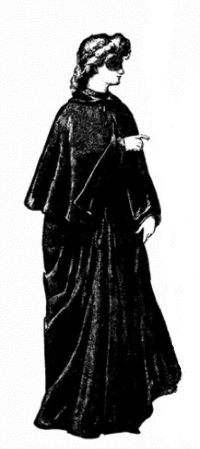(Here's a set of descriptions of the classic domino, a robe-like costume which dates back to the masquerades of the 18th century and is more associated with masquerades (masked balls) than fancy dress events, but still seem to have turned up occasionally. The English in particular appear to have continued to use dominos and evolved a lot of rather frou-frou variations barely related to the original concept of the simple black robe.)

1880, English:
DOMINO. Worn at masque balls and sometimes as a fancy dress. They are made in satin, silk, and brocade, or of plain cotton in the Princess shape, having often a Watteau plait with capes and large hoods and wide sleeves. They should be large and long enough to slip over the dress easily, and hide it completely. The black are usually trimmed with a colour, such as a thick ruching down the front and round the tunic-shaped sleeves, and are often piped with a colour and lined with the same.
1887, English:
DOMINO, A. Worn at masque balls and sometimes as fancy dress. It is made in satin, silk, and brocade, or of plain cotton in the Princess shape, having often a Watteau plait with cape and slender-pointed hood and wide sleeves. It should be large and long enough to slip over the dress easily, and hide it completely. The black are usually trimmed with a colour, such as a thick ruching down the front and round the bell-shaped sleeve, and are often piped with a colour and lined with the same. The lighter tones sometimes edged with swansdown.
1896, English:
DOMINO, A. Worn at masque balls and sometimes as a fancy dress. It is made in satin, silk, and brocade, or of plain cotton in the Princess shape, having often a Watteau plait with cape and slender-pointed hood and wide sleeves. It should be large and long enough to slip over the dress easily, and hide it completel. Black is usually trimmed with a color, in the form of a thick ruching down the front and round the bell-shaped sleeves, and are often piped with a color and lined with the same. The newest kinds are made in chiffon and gaily trimmed with flower. White satin is covered with white chiffon and lilies of the valley are dispersed all over it, falling in a shower; the cape is formed of boullonnees of chiffon; blue satin dominoes are turned back with pink roses. Handsome velvet and satin brocades are employed on some with no capes, but full bishop sleeves and lace ruffles are gathered from the neck beneath a double frill of lace. The Merveilleux Domino is trimmed at the hem with festoons of old lace caught up with pink bows repeated on the shoulders; the large sleeves coming from the plait at the back. Some are parti-colored half black half cerise. A white brocade might have an accordion pleated cape, pink, flame color, black and yellow are effective.
1906, American:
Domino
Black silk, sateen or woollen material is selected to develop this popular garment. A silk cord, knotted, encircles the waist and is tied in front. Mask of black satin. (Illustrated above right; click the image to enlarge.)
Sources:
Holt, Ardern. Fancy Dresses Described, 2nd Edition, Illustrated. London: Debenham & Freebody, 1880.
Holt, Ardern. Fancy Dresses Described, 5th Edition. London: Debenham & Freebody, 1887.
Holt, Ardern. Fancy Dresses Described, Sixth Edition. London: Debenham & Freebody, 1896.
Masquerades, Tableaux and Drills. New York: The Butterick Publishing Company, 1906.
The 1896 edition of Holt may be found online at the University of Wisconsin Digital Collections.
(Back to school time with an Edwardian schoolboy costume, which was probably an easy fancy dress choice for a young boy who could simply use his own school clothes or uniform. Yes, despite the long hair, that's a boy.)